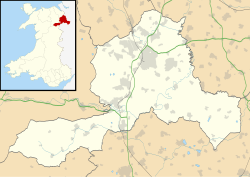
Back Рексем округы Bashkir Рэксем Byelorussian Рексъм Bulgarian Kontelezh Wrecsam Breton Wrexham Catalan Wrexham (munisipyo) CEB Wrecsam (sir) Welsh Wrexham County Borough German Wrexham (autoridad unitaria) Spanish Wrexham (tervikomavalitsus) Estonian
Wrexham County Borough
Bwrdeistref Sirol Wrecsam (Welsh) | |
|---|---|
| |
| Motto(s): | |
 Wrexham shown within Wales | |
| Coordinates: 53°03′N 3°00′W / 53.05°N 3.00°W | |
| Sovereign state | United Kingdom |
| Country | Wales |
| Preserved county | Clwyd |
| Formation of County Borough | 1 April 1996 |
| Administrative HQ | Guildhall |
| Government | |
| • Type | Principal council |
| • Body | Wrexham County Borough Council |
| • Control | No overall control |
| • MPs | 3 MPs
|
| • MSs | 2 MSs
|
| Area | |
| • Total | 195 sq mi (504 km2) |
| • Rank | 10th |
| Population (2022)[2] | |
| • Total | 135,394 |
| • Rank | 10th |
| • Density | 700/sq mi (269/km2) |
| Time zone | UTC+0 (GMT) |
| • Summer (DST) | UTC+1 (BST) |
| ISO 3166 code | GB-WRX |
| GSS code | W06000006 |
| Website | wrexham |
Wrexham County Borough (Welsh: Bwrdeistref Sirol Wrecsam) is a county borough, with city status,[3] in the north-east of Wales. It borders the English ceremonial counties of Cheshire and Shropshire to the east and south-east respectively along the England–Wales border, Powys to the south-west, Denbighshire to the west and Flintshire to the north-west. The city of Wrexham is the administrative centre. The county borough is part of the preserved county of Clwyd.
The county borough has an area of 193 square miles (500 km2) and a population of 136,055. The north of the county borough is relatively urbanised and centred on Wrexham, with a population of 44,785, its industrial estate and several outlying villages, such as Brynteg and Gwersyllt. To the north east is the border village of Holt, while to the south of Wrexham, Rhosllanerchrugog, Ruabon, Acrefair and Cefn Mawr are the main urban villages. Further south again is the town of Chirk, near the border with Shropshire, while the Ceiriog Valley to the south-east and English Maelor to the south-west of the county borough are rural. The county borough was historically split between Denbighshire and Flintshire, with it all later being part of the county of Clwyd.
The county borough is flat in the east and hilly in the west. The long salient to the south-west incorporates most of the Ceiriog Valley and includes part of the Berwyn range. The River Ceiriog forms part of the Shropshire border in its lower stages before meeting the Dee east of Chirk. The Dee itself enters the county borough near Cefn Mawr and flows east and then north-east toward Cheshire, creating a wide plain. It forms part of the border before fully entering England at the county borough's north-east corner. The north-west of the county borough, down to Chirk, is part of the Clwydian Range and Dee Valley AONB, and includes the Ruabon Moors uplands.
Wrexham includes the remains of two significant medieval castles: Chirk, which is now a country house, and Holt, of which only fragments remain. The county borough has a strong industrial history; a notable early business is Bersham Ironworks, in the Clywedog Valley, which operated between 1715 and 1812 and pioneered cannon manufacture. The area is part of the North Wales Coalfield and significant mining took place in the nineteenth century. Tanning and brewing were also significant industries. The Pontcysyllte Aqueduct near Cefn Mawr is an important surviving piece of early industrial infrastructure and has been designated a UNESCO World Heritage Site. The contemporary economy of the county borough has diversified into industries such as engineering, pharmaceuticals, electronics, and food processing, with agriculture dominant in the south-east and south-west. The county borough also contains Wrexham University, one of Wales' three Roman Catholic cathedrals, Wrexham Industrial Estate and the UK's largest prison, HMP Berwyn.
- ^ "Council and democracy". Wrexham County Borough Council. Retrieved 6 August 2024.
- ^ a b "Mid-Year Population Estimates, UK, June 2022". Office for National Statistics. 26 March 2024. Retrieved 3 May 2024.
- ^ "Crown Office | The Gazette". www.thegazette.co.uk. Retrieved 5 September 2022.
THE QUEEN has been pleased by Letters Patent under the Great Seal of the Realm dated 1 September 2022 to ordain that the County Borough of Wrexham shall have the status of a City.



